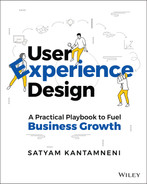CHAPTER 14
USER EMPATHY PLAY: How do I develop enough understanding to truly empathize with my user?
Creating a user‐centric experience requires more than simply understanding your users’ domain and what tasks they need to perform—it requires deep empathy. Empathy helps you avoid making erroneous assumptions about your users and instead uncover new opportunities based on what they actually want and need. This play is foundational to all subsequent plays because it will help you develop that deep understanding of who your users are, what their needs are, and which problems to solve for them. These insights will guide the decisions you make about your design and your product strategy in a way that puts the user first.
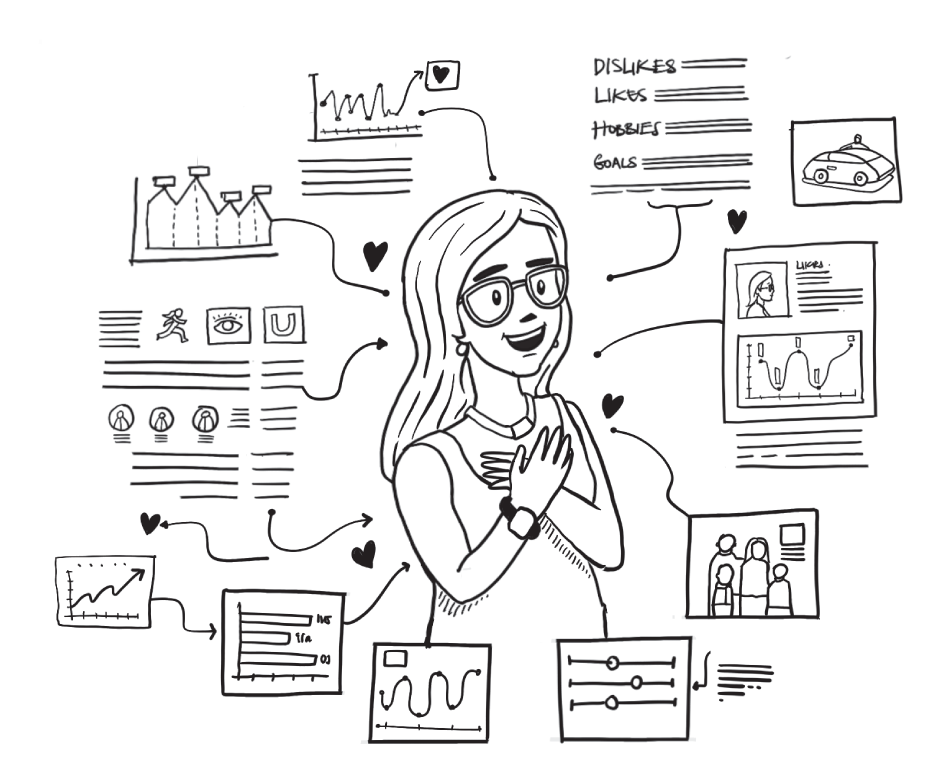
Who Are the Key players in the User Empathy play?
| ROLE | WHO’S INVOLVED | RESPONSIBILITIES |
|---|---|---|
 DRIVER | Experience strategist |
|
 CONTRIBUTOR | User researcher; peer practitioner (e.g. product manager, engineering manager, other internal stakeholders) |
|
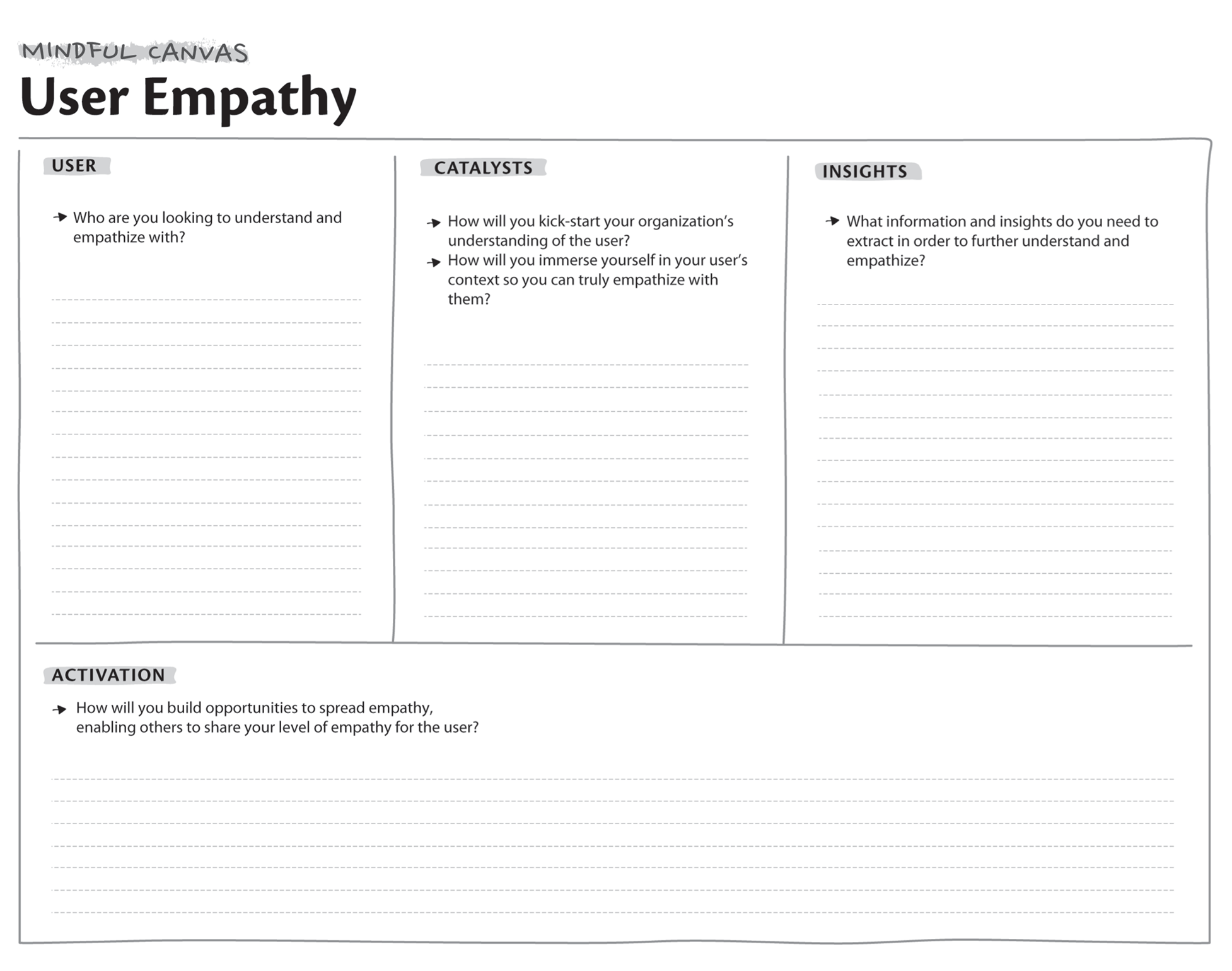
THE HOW
To run an effective user empathy play, you need to be mindful of:
1. The USER You Want to Develop Empathy For
Your organization exists to add value to those who you serve. More likely than not, your organization or system contains a number of users, both internal (e.g. employees, partners, vendors) and external (e.g. customers, sales partners, consultants). Identify the specific user(s) you want to develop empathy for.
Ideally you should work on building empathy for each and every user in the context of your system. However, always try to prioritize the top users based on a business goal (e.g. exploring an untapped market), a product goal (e.g. enhancing the user experience), or a user goal (e.g. understanding user motivations and pain points). Knowing why you are looking to understand your users will anchor your research and ensure your original intent is met.
2. The CATALYSTS for Building Empathy
Building user empathy begins with suspending your own assumptions and instead striving to understand your user by stepping into their shoes or conducting research (Chapter 25: “Picking a Research Method Play”). Here are some techniques you can use to start the process:
- In‐depth interviews: This technique involves speaking with the user directly, usually in a one‐on‐one setting. The goal is to listen and understand. Therefore, it’s best to give the users the time and space to speak freely and openly. Ask probing questions to dig deeper. Refrain from judgment and avoid guiding them on how to answer the questions.
- Ethnographic studies: This technique immerses researchers into the “field,” the real‐world living and working environment of the users you are studying. It is a tremendously valuable method for gaining contextual understanding of what people do, how they do it, and why they do it, especially if you have a very basic level of knowledge about your users and if your user’s natural environments are vastly different than yours.
- User testing: This technique involves watching real users interact with a product or design; it’s typically implemented after a product or prototype has been built. The goal of this technique is to set aside your own assumptions and empathize with the user about what they see, know, can do, and can’t do.
- Role play: In this technique, the stakeholders who are engaged in strategizing, designing, and developing the products “become” the users themselves, adopting their physical, emotional, and psychological attributes.

Simulate their environments
Ford engineers wear suits that simulate the different types of body problems (e.g. backaches, joint problems) their customers might have in order to better understand how to design with end users in mind.
Trying things yourself elicits more visceral reactions, allowing you to resonate with the user and gain a deeper understanding of the people you are designing for. Keep in mind that this method should not replace or be classified as “user research,” because you are not engaging with an actual user.
3. What INSIGHTS Are Necessary to Understand Your User
As you immerse yourself in the user’s context, extract and collect valuable insights to deepen your empathy for the user. Dig deeper by trying to understand their role, responsibility, goal (intent), journey, larger ecosystem, success criteria, joys, and pain points to name a few areas to be mindful of.
- Your Users’ Roles: Learn how your users describe and perceive their roles and more specifically, how they describe the purpose of their roles. Some helpful questions to inquire include:
- What does your role entail?
- What kind of outcomes are you responsible for?
- What outcome are you looking to achieve in [context]?
- Why do you use [certain products/services]?
In the ecosystem of a school, here are some roles and their purpose as perceived by a key user: elementary school teacher Ms. Smith:
- Your Users’ Responsibilities: “Responsibilities” describe what users do and the outcome they are aiming for. When building user empathy/running the user empathy play, look for details such as how your users break down their day, what tasks or activities they perform, and how they achieve their outcomes. Some illuminating questions to ask include:
- What does a typical day look like for you? If it helps, let’s take a look at what your day was like yesterday.
- What goes into getting an outcome done?
- What tasks do you perform regularly? Weekly? Monthly?
- What do you spend the most time doing? Why?
- Your User’s Journeys: Users rarely have just one touchpoint with your organization, product, or service. Rather, their experience is shaped by a multitude of interactions along a journey. A user journey illustrates this flow, providing a comprehensive, chronological recording of all the interactions, along with accompanying emotional states, that your users experience.
Insights from your user’s journey are invaluable as you run the user empathy play. To gather these insights, inquire about:
- What outcome are you looking to achieve?
- What are the major phases of the journey?
- What is your intent during the journey? Or during the different parts of the journey?
- What actions or activities are performed?
- What level of frustration or delight do the users display or verbalize?
- How efficient were they in completing the task? Where did they take too many steps?
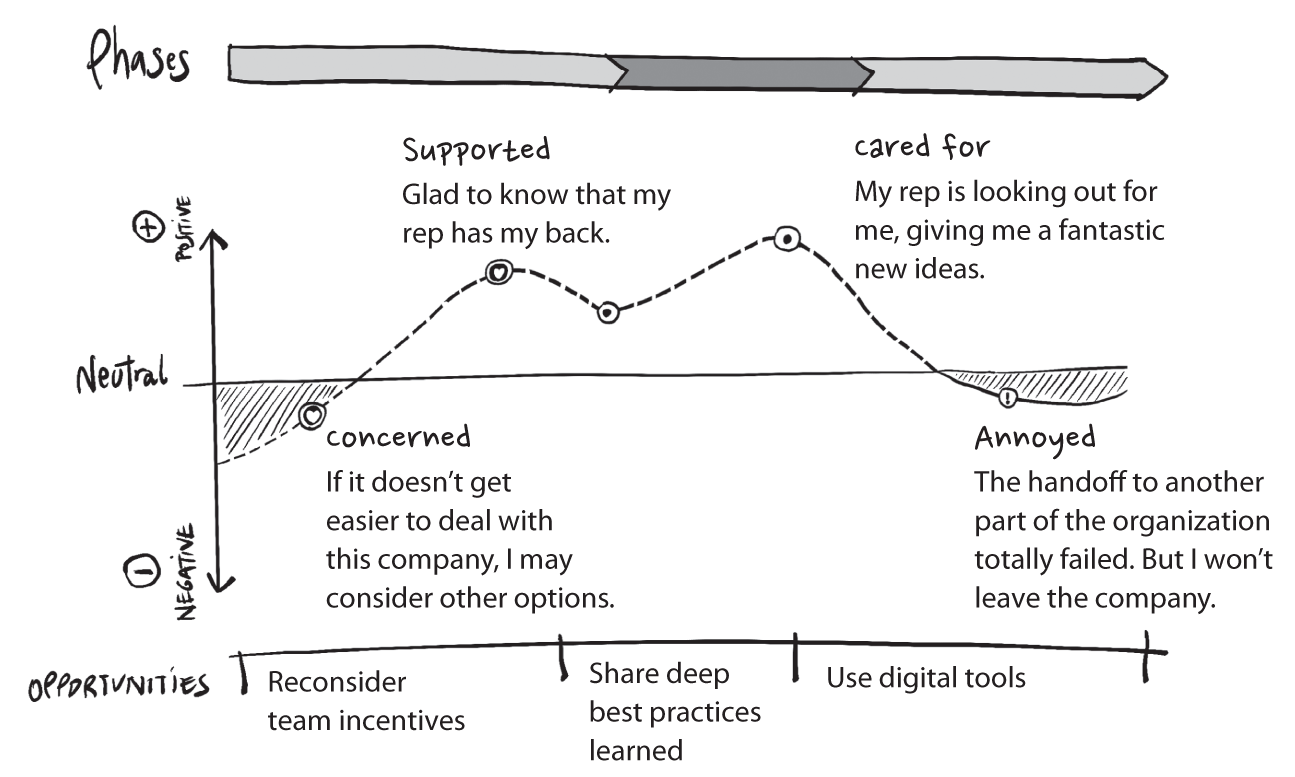
- Your User’s Larger Ecosystems: In order to understand your user’s place in the larger ecosystem, find out what other people, tools, and resources they interact with. Not only will this help build your knowledge of and empathy for these particular users, but it may also help you discover other relevant users and objects.
Inquire about:
- Whom do you interact with to get [an outcome] done?
- Who else do you interact with, and why?
- What kinds of tools do you use to get [a task] completed?
- What is your reporting structure, and what is your working relationship with the people in these roles?
Your user’s end‐to‐end experience is the summation of all their journeys and the interactions they’ve had with different people, tools, and technologies. Therefore, you have to take into consideration the ecosystem—the complex network of interconnected systems that your user inhabits—to get a fuller picture of why they may react or behave a certain way.
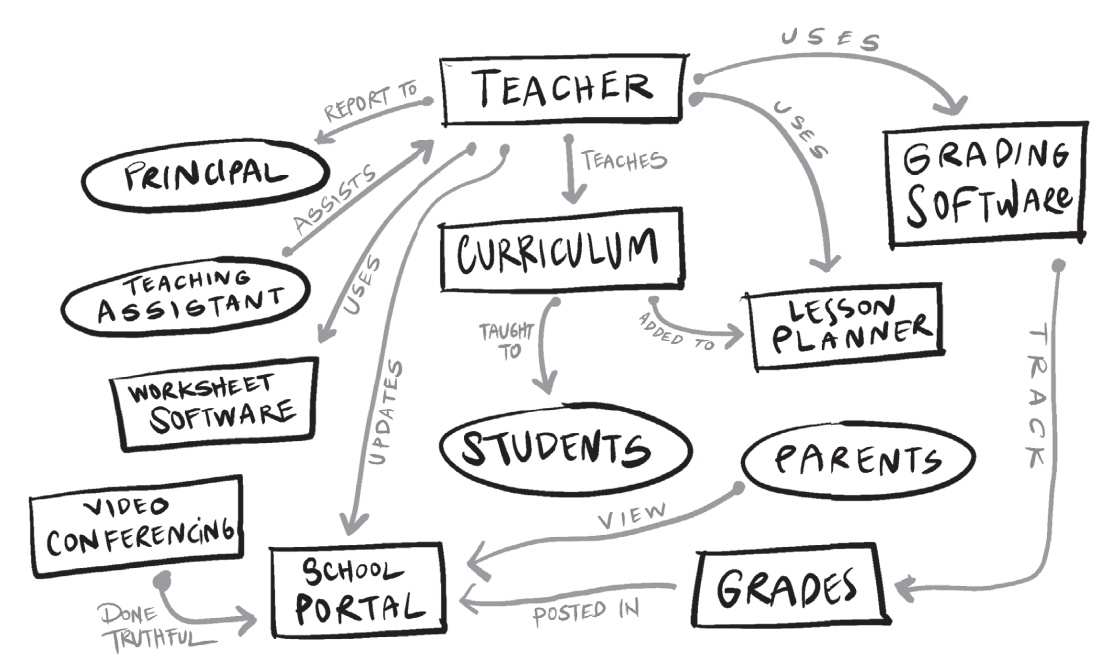
- Your User’s Success Qualities: Insights into how your users measure success and what they need to be successful will also help you understand how to design experiences in a way that drives value to your users.
Some helpful questions to understand include:
- What makes someone successful in this role?
- When hiring for this role, what qualities do you look for?
- What are some things you struggle with when getting [outcome] done?
- What kind of skills or knowledge do you think would be helpful in getting [outcome] done?
- What does success look like and who measures it?
- Your User’s Joys: Understanding what your users like—what brings them joy—will help you get a sense of what their motivations are, uncover opportunities for delight, and discover unmet needs in their current experiences. These can be joys that users state or joys that you observe during research.
Some helpful questions to inquire include:
- What are your top three favorite things about your job?
- What was your best experience with getting [outcome] done?
- If you had more free time, what would you want to spend that time doing?
- What was your most memorable day at work? What set that day apart?
- Your User’s Pain Points : Knowing and empathizing with your users’ pain points sets a baseline for which problems to solve. These can be pain points that your users bring up themselves or pain points that you observe during research.
Some helpful questions to understand include:
- What are the top three most frustrating things about your job?
- What was your worst experience when trying to get [outcome] done?
- What are the most time‐consuming or mundane tasks you would like to remove from your routine?
- What was your worst day at work? What set that day apart?
- Your User Segments: Are you looking to gain empathy for one particular population in a large and diverse group? Separate the group out into user segments—users with similar roles as the whole, but who operate in a specific context—and identify the segments you are looking to understand. What broad attributes do they share?
- High school teachers vs. elementary school teachers;
- Customer service agents in insurance vs. customer service agents in e‐commerce;
- Luxury ride‐share user vs. budget ride‐share user;
- Experienced users vs. novice users.
Identify notable groupings of users based on demographic, psychographic, behavioral, and geographic attributes, or even levels of experience. Knowing these segments will provide guidance for follow‐on user research recruitment, data synthesis, and even business decisions such as what kinds of offerings to provide for a particular segment.
- Aha Moments: Aha moments are moments of sudden insight and clarity that have an oversized impact on the user. An aha moment could be the instant when a user understands the value they get from a product or when the researcher learns something completely new and wholly unexpected that leads to a product development breakthrough.
4. Ways to Build ACTIVATION and Spread Empathy
Data is only as valuable as the insights it informs and knowledge it builds in others. That’s where artifacts and socialization kick in.
- Artifacts: Distill what you’ve learned in user research and translate the insights into shareable artifacts such as user personas, empathy maps, user journeys, and video reels. Use these artifacts to foster empathy for your users even beyond those who were directly involved in the research. One word of caution: The mere development of artifacts does not automatically translate into deepened empathy for the user. The artifacts are useless unless they are filled with rich insights and achieve your original objective.
- Socialization: Empathy is a core pillar of all user‐first cultures; it isn’t “mission accomplished” when you’ve completed your research and finalized your artifacts. Socialize your findings with anyone who plays a role in shaping the ultimate user experience. Share video reels and soundbites from actual users so the greater organization can have a heightened sense of empathy for the people you are designing for (Chapter 17: “Shared Empathy Play”).
IN ORDER TO MAXIMIZE THE VALUE OF THIS PLAY
- Distinguish between assumptions and fact: Clearly separate insights derived from users with those that were hypothesized by non‐users. Assumptions need to be further validated by research.
- Empathy is not a one‐and‐done exercise: It’s an ongoing process. Continue to learn about your users with every interaction, and continue to add your learnings to your research repository.
- Call your users by an identifiable name: “We need to solve this problem for the user” is not as personal as “We need to solve this problem for Sam.” Humanize your users and increase your organization’s empathy for them by talking about your users often and by name.
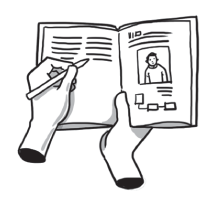 RELATED PLAYS
RELATED PLAYS
- Chapter 17: “Shared Empathy Play”
- Chapter 18: “Experience Ecosystem Play”
- Chapter 30: “User Research Program Play”
- Chapter 34: “Design Problems and Opportunities Play”
